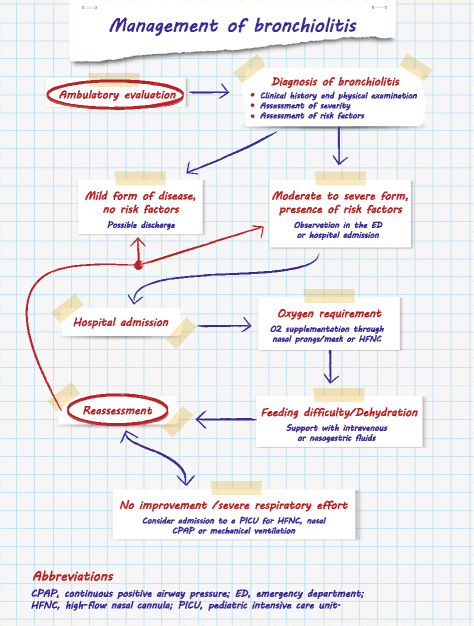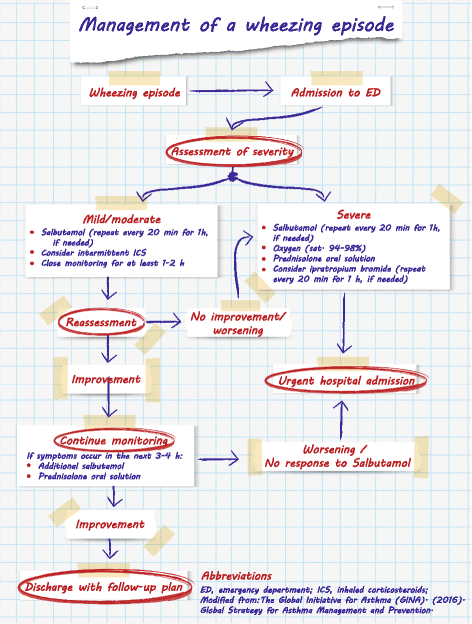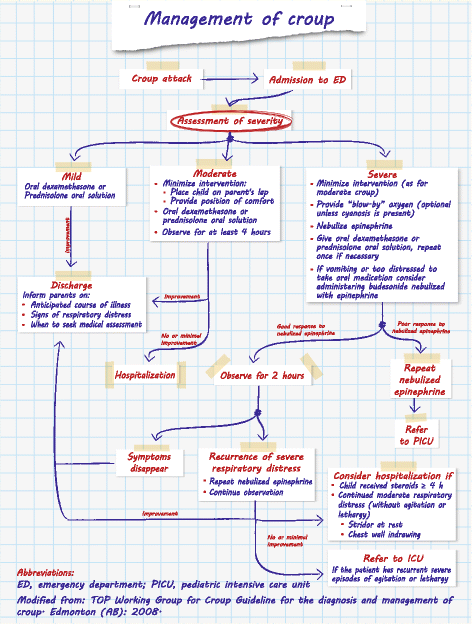Management of acute respiratory diseases in the pediatric population: the role of oral corticosteroids
- PMID: 28335827
- PMCID: PMC5364577
- DOI: 10.1186/s13052-017-0348-x
Management of acute respiratory diseases in the pediatric population: the role of oral corticosteroids
Abstract
Respiratory diseases account for about 25% of all pediatric consultations, and 10% of these are for asthma. The other main pediatric respiratory diseases, in terms of incidence, are bronchiolitis, acute bronchitis and respiratory infections. Oral corticosteroids, in particular prednisolone, are often used to treat acute respiratory diseases given their anti-inflammatory effects. However, the efficacy of treatment with oral corticosteroids differs among the various types of pediatric respiratory diseases. Notably, also the adverse effects of corticosteroid treatment can differ depending on dosage, duration of treatment and type of corticosteroid administered - a case in point being growth retardation in long-course treatment. A large body of data has accumulated on this topic. In this article, we have reviewed the data and guidelines related to the role of oral corticosteroids in the treatment and management of pediatric bronchiolitis, wheezing, asthma and croup in the attempt to provide guidance for physicians. Also included is a section on the management of acute respiratory failure in children.
Keywords: Acute respiratory diseases; Asthma; Bronchiolitis; Croup; Respiratory failure; Wheezing.
Figures




Similar articles
-
The Cochrane Library and safety of systemic corticosteroids for acute respiratory conditions in children: an overview of reviews.Evid Based Child Health. 2014 Sep;9(3):733-47. doi: 10.1002/ebch.1980. Evid Based Child Health. 2014. PMID: 25236311 Review.
-
Update on the utility of corticosteroids in acute pediatric respiratory disorders.Allergy Asthma Proc. 2015 Sep-Oct;36(5):332-8. doi: 10.2500/aap.2015.36.3865. Allergy Asthma Proc. 2015. PMID: 26314814 Free PMC article. Review.
-
Acute obstructive respiratory tract diseases in a pediatric emergency unit: evidence-based evaluation.Pediatr Emerg Care. 2012 Dec;28(12):1321-7. doi: 10.1097/PEC.0b013e3182768d17. Pediatr Emerg Care. 2012. PMID: 23187991
-
Corticosteroids in respiratory diseases in children.Am J Respir Crit Care Med. 2012 Jan 1;185(1):12-23. doi: 10.1164/rccm.201107-1174CI. Am J Respir Crit Care Med. 2012. PMID: 21920920 Review.
-
Quality of care for common pediatric respiratory illnesses in United States emergency departments: analysis of 2005 National Hospital Ambulatory Medical Care Survey Data.Pediatrics. 2008 Dec;122(6):1165-70. doi: 10.1542/peds.2007-3237. Pediatrics. 2008. PMID: 19047229
Cited by
-
Agreements and controversies of national guidelines for bronchiolitis: Results from an Italian survey.Immun Inflamm Dis. 2021 Dec;9(4):1229-1236. doi: 10.1002/iid3.451. Epub 2021 Oct 22. Immun Inflamm Dis. 2021. PMID: 34677899 Free PMC article.
-
Effect of glucocorticoid therapy on long-term growth and development of children with bronchiolitis.Zhongguo Dang Dai Er Ke Za Zhi. 2022 Mar 15;24(3):261-265. doi: 10.7499/j.issn.1008-8830.2110071. Zhongguo Dang Dai Er Ke Za Zhi. 2022. PMID: 35351255 Free PMC article. Chinese, English.
-
Burden of Acute Respiratory Infections Among Under-Five Children in Relation to Household Wealth and Socioeconomic Status in Bangladesh.Trop Med Infect Dis. 2019 Feb 12;4(1):36. doi: 10.3390/tropicalmed4010036. Trop Med Infect Dis. 2019. PMID: 30759811 Free PMC article.
-
Optimizing respiratory management in preterm infants: a review of adjuvant pharmacotherapies.J Perinatol. 2021 Oct;41(10):2395-2407. doi: 10.1038/s41372-021-01139-x. Epub 2021 Jul 9. J Perinatol. 2021. PMID: 34244615 Review.
-
Advances in pediatrics in 2017: current practices and challenges in allergy, endocrinology, gastroenterology, genetics, immunology, infectious diseases, neonatology, nephrology, neurology, pulmonology from the perspective of Italian Journal of Pediatrics.Ital J Pediatr. 2018 Jul 17;44(1):82. doi: 10.1186/s13052-018-0524-7. Ital J Pediatr. 2018. PMID: 30016966 Free PMC article. Review.
References
-
- Sestini P, De Sario M, Bugiani M, Bisanti L, Giannella G, Kaisermann D, et al. Frequency of asthma and allergies in Italian children and adolescents: results from SIDRIA-2. Epidemiol Prev. 2005;29:24–31. - PubMed
-
- Indinnimeo L, Porta D, Forastiere F, De Vittori V, De Castro G, Zicari AM, et al. Prevalence and risk factors for atopic disease in a population of preschool children in Rome: challenges to early intervention. Int J Immunopathol Pharmacol. 2016;29:308–319. doi: 10.1177/0394632016635656. - DOI - PMC - PubMed
Publication types
MeSH terms
Substances
LinkOut - more resources
Full Text Sources
Other Literature Sources
Medical

